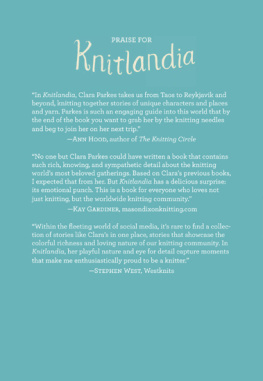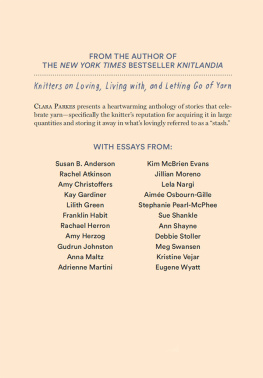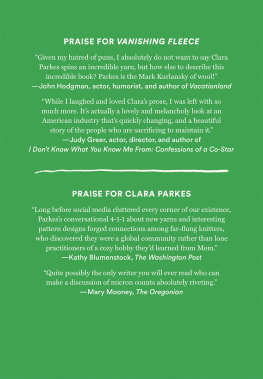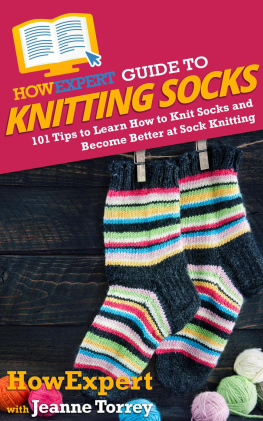
Published in 2016 by Stewart, Tabori & Chang
An imprint of ABRAMS
Copyright 2016 Clara Parkes
All rights reserved. No portion of this book may be reproduced, stored in a retrieval system, or transmitted in any form or by any means, mechanical, electronic, photocopying, recording, or otherwise, without written permission from the publisher.
Library of Congress Control Number: 2015948556
ISBN: 978-1-61769-190-4
eISBN: 978-1-61312-939-5
Editor: Melanie Falick
Designer: Sebit Min
Production Manager: True Sims
The text of this book was composed in Archer.
Stewart, Tabori & Chang books are available at special discounts when purchased in quantity for premiums and promotions as well as fundraising or educational use. Special editions can also be created to specification. For details, contact specialsales@abramsbooks.com or the address below.

115 West 18th Street
New York, NY 10011
www.abramsbooks.com
CONTENTS
PREFACE: In Motion
WHEN I WAS SIX, I went with my mother on a run to the grocery store. Too busy to fiddle with the garage door when we got back, she parked the car in the driveway and went inside, letting me snooze as she often did. Eventually I woke up, unbuckled myself, and came in for lunch. A few minutes later, a man in uniform knocked on our door and said, Your car is on fire.
A plume of smoke billowed from the frame of what had been, until a few minutes earlier, our trusty VW Bus. A fuel line mustve snapped, they said, spilling gasoline onto the still-hot engine until it ignited. All four tires had melted and the windows had shattered into a million tiny pieces. Youd think the experience would have put me off cars completely. Strangely enough, it didnt. If anything, it only reinforced my desire to set the wheels in motion, as if the real danger were in sitting still.
I grew up with grand road trips, coast-to-coast adventures in unreliable cars, playing Mad Libs and counting license plates. After my parents divorce, my mother moved us to Tucson, where we found smaller ways to escape. Some weekends, after giving up on waiting for a boyfriend to call, shed mutter a curse and load us into the car. Windows open, we chased the sunset down Speedway Boulevard until the streetlights and sidewalks gave way to empty desert and the tall shadows of saguaros.
We snaked our way up, up, up, until a sudden sharp left turn took us over Gates Pass. Ahead, the view opened up to nothingness. Back down the mountain we went, to an empty desert floor. Wed find a spot and pull over. The moment the car went silent, the desert took over. A brilliant city of lights unfolded in the sky above as our eyes grew accustomed to the darkness. My mother would lie on the hood of the car; my brothers and I, like rattlesnakes, preferred the warmth of blacktop on the empty road. The desert air smelled sweet and exotic. Lying there, my entire area of vision was filled with stars. At any minute, it felt like gravity would reverse and the sky would suck me in. Id fall up, up, up into the cosmos.
Eventually my mom would call to us and wed get back in the car. As soon as we drove back through Gates Pass, the lights of Tucson would twinkle in the distance, like jewels on black velvet, beckoning us home. We hadnt gone far, but that brief interlude away, even just over the pass, fulfilled my need to wander.
My first real job after college was as a travel writer for a pre-Internet publisher. Rarely did my fellow writers and I go anywhere. We called venues and interviewed people who had no idea they were being interviewed. We scoured sources, worked with stringers on location, and managed to piece together fresh, original information. We became masters of the blurb. Colleague John Pinson and I even won an award from the Society of American Travel Writers Foundation for our work. The year was 1995.
When that job ended and I moved into high-tech publishing, I became a business traveler. From convention center to conference center to major hotel chain Id go, from lobby to ballroom back to airport, to cover events with names like Database and Client/Server World and DB Expo. Id sit in product briefings with various VPs of technology, and every second felt like a race to see if I could get out before they realized how little I understood.
I was still working at my day job in high-tech when I launched my online knitting magazine, Knitters Review, in 2000. My goal was to be the eyes and fingers for knitters during a time when our world was exploding with new yarns, tools, books, gadgets, and events. That fall, I ventured to my first sheep-and-wool festival. It was in Vermont, and I called the number listed on the program to ask a question. The woman was quite friendly, and before long, she was offering me her home for the weekend. Ill be up at the lodge anyway, she said, so youd have the place all to yourself.
I declined, figuring she might also be the kind of person who kept dead cats in her freezer. But when I got to the show, that same friendliness prevailed. Nobody knew who I was or what I was up to, they were just beingor at least they seemed to begenuinely nice. They were eager to share their stories, answer my questions, and offer advice. The interactions energized me. I enjoyed it so much that I went to another festival, then another, then another.
Knitting has offered me a perfect lens through which to see the world. During my fifteen years writing Knitters Review, Ive clocked so many miles that Ive essentially taken off or landed once every two weeks. My destination has never been a shiny skyscraper or boardroom. Ive been headed to a yarn store, a spinning mill, a sheep-and-wool festival, perhaps a hotel or conference center taken over, even if only briefly, by knitters. The specifics of the trips varied, but my underlying mission was always the same. I have become a yarn evangelist, and I travel in search of my congregation.
The stories in this book follow those years, beginning in 2000, when the Internet was in its relative infancy, when email newsletters such as mine were still a novel way to reach and build community among what we thought was a small group of knitters online. They track the riseand occasional fallof our important gatherings, our people and places, landmarks and legends, each of which has played a vital role in the vibrant knitting culture and community that exist today.
CHASING A LEGEND IN TAOS
ONCE UPON A TIME in a Taos, New Mexico, grocery store, a woman named Luisa Gelenter was going about her business buying food. Somewhere in the produce section, she felt a person standing too close. Inching away, she kept shopping, only to feel this person creep up on her again. Annoyed, she stomped off to another aisle. When the lurker soon reappeared, Luisa turned and snapped, What do you want? The words were barely out of her mouth when she recognized it was Julia Roberts. The movie star and avid knitter happened to be a big fan of Luisas work and was too shy to introduce herself.
Who knows how it really played out, but thats the story Luisa loved to tell.
In the world of yarn, Luisa Gelenter was a legend. Using nothing more than water and select minerals, bugs, skins, branches, roots, leaves, petals, and powders, from knowledge she picked up in Bolivia in the early 1970s, she could transform natural fibers, such as humdrum wool and mohair, into vibrant, magical yarns for knitting, weaving, and other creative pursuits. Some of her yarns were ultimately spun by a machine at a mill, but in the beginning, all of her fiber was farmed out to a squad of loyal handspinners who produced luminous, lively, color-laden skeins that were truly one of a kind. A complete garment in these yarns cost a fortune and was worthy of any red carpet.
Next page






